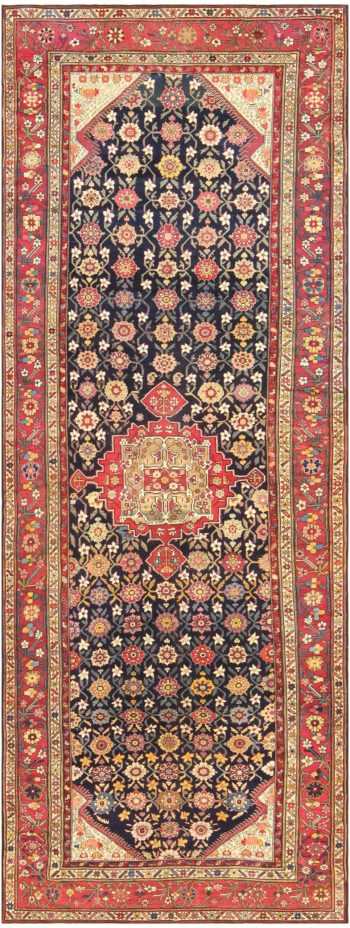Runner Rugs
Below you can view our current collection of antique runner rugs and hallway carpet runners
-
Long and Narrow Ivory Antique Indian Agra Runner Rug 49752
$12,500.00Size: 4 ft 6 in x 26 ft 6 in (1.37 m x 8.08 m) -
Brown Modern Moroccan Design Hallway Runner Rug 61007
$5,355.00Size: 2 ft 7 in x 24 ft 7 in (0.79 m x 7.49 m) -
Vintage Scandinavian Runner Rug by Gunilla Lagerhem Ullberg 49437
$14,500.00Size: 3 ft 10 in x 23 ft 3 in (1.17 m x 7.09 m) -
Antique Indian Amritsar Hallway Runner Rug 41971
$14,500.00Size: 2 ft 4 in x 22 ft 5 in (0.71 m x 6.83 m) -
Tribal Antique Persian Serab Runner Rug 71463
$11,500.00Size: 3 ft 7 in x 21 ft (1.09 m x 6.4 m) -
Neutral Earthy Long and Narrow Modern Hallway Flatweave Runner Kilim Rug 11003
$3,080.00Size: 4 ft 5 in x 20 ft (1.35 m x 6.1 m) -
Tribal Light Blue Turkish Oushak Design Modern Long Hallway Runner Rug 11208
$3,920.00Size: 3 ft 2 in x 19 ft 7 in (0.97 m x 5.97 m) -
Beautifully Tribal Antique Caucasian Karabagh Runner Rug 48096
$26,000.00Size: 7 ft 5 in x 19 ft 7 in (2.26 m x 5.97 m) -
Tribal Long Antique Navy Northwest Persian Runner Rug 49586
$18,500.00Size: 3 ft 10 in x 19 ft 5 in (1.17 m x 5.92 m) -
Rustic Antique Persian Senneh Golfarang Design Hallway Runner Rug 72045
$8,800.00Size: 3 ft 8 in x 19 ft 3 in (1.12 m x 5.87 m) -
Ivory Antique Persian Sultanabad Runner Rug 50412
Size: 5 ft x 19 ft 3 in (1.52 m x 5.87 m) -
Antique Caucasian Karabagh Long Runner Rug 44441
$9,800.00Size: 3 ft 7 in x 19 ft 3 in (1.09 m x 5.87 m) -
Cream Color Modern Moroccan Style Runner Rug 61063
$3,675.00Size: 3 ft 4 in x 19 ft (1.02 m x 5.79 m) -
Primitive Antique Caucasian Karabagh Brown Runner Floral Rug 50141
$14,000.00Size: 3 ft 9 in x 19 ft (1.14 m x 5.79 m) -
Cream Color Modern Moroccan Design Runner 61060
$3,150.00Size: 3 ft x 18 ft 7 in (0.91 m x 5.66 m) -
Antique Caucasian Karabagh Tribal Geometric Paisley Design Long and Narrow Hallway Runner Rug 72670
Size: 3 ft 3 in x 18 ft (0.99 m x 5.49 m) -
19th Century Antique Tribal North West Persian Hallway Runner Rug 72107
$16,500.00Size: 2 ft 7 in x 18 ft (0.79 m x 5.49 m) -
Antique Tribal Geometric Caucasian Karabagh Paisley Design Hallway Runner Rug 72669
$12,000.00Size: 3 ft 3 in x 17 ft 10 in (0.99 m x 5.44 m) -
Antique Persian Shield Design Kerman Gallery Runner Rug 71723
$26,500.00Size: 5 ft 10 in x 17 ft 9 in (1.78 m x 5.41 m) -
Rustic Antique Tribal Persian Herati Malayer Abrashed Hallway Runner Rug 48308
$12,500.00Size: 5 ft x 17 ft 3 in (1.52 m x 5.26 m) -
Blue Background Antique Persian Malayer Runner Rug 72053
$3,750.00Size: 3 ft 5 in x 17 ft (1.04 m x 5.18 m) -
Tribal Antique Gold Caucasian Kuba Runner Rug 71989
$11,750.00Size: 3 ft x 16 ft 10 in (0.91 m x 5.13 m) -
Modern Moroccan Design Runner Rug 60981
$3,750.00Size: 2 ft 4 in x 16 ft 9 in (0.71 m x 5.11 m) -
Tribal Paisley Design Antique Persian Malayer Runner Rug 50671
$12,500.00Size: 3 ft 7 in x 16 ft 6 in (1.09 m x 5.03 m)
Learn More About Antique Hallway Runner Rugs
What is a runner rug?
Runners and antique runner rugs are any carpets that are characterized by a long and narrow format. Generally, carpet runners are well suited for hallways and stairways. Runner rugs have historically been produced in many different rug-producing countries, and may be Persian rugs, Turkish rugs, or rugs from any other origin.
What size rug is considered a runner?
A runner is a specific type of rug that is typically long and narrow, designed to fit in narrow spaces such as hallways, staircases, or entryways. While there is no strict rule regarding the size of a runner, they are generally much longer than they are wide. Common dimensions for a runner rug might range from 2 to 3 feet in width and 8 to infinity feet in length. However, the exact size can vary based on personal preference, the dimensions of the space, and the specific area you intend to place the runner.
What type of rug is best for a hallway runner rug?
Choosing the best type of rug for a hallway runner depends on several factors, including the style of your home, your personal preferences, and the amount of foot traffic in the area.
Here are some popular runner rug options to consider:
- Low-Pile Rugs:
- Low-pile rugs have shorter fibers, which makes them easier to clean and less prone to showing wear. They are a practical choice for high-traffic areas like hallways.
- Flatweave Rugs:
- Flatweave rugs, such as dhurries or kilims, are thin and have a flat, woven texture. They are durable and often a good choice for hallways where doors need to open over the rug.
- Indoor-Outdoor Rugs:
- These rugs are made from materials that can withstand outdoor conditions, making them resistant to moisture and easy to clean. They are a practical choice for hallways that may see a lot of traffic and potential spills.
- Runner Rugs with Patterns:
- Patterns can be a good choice for hallways, as they can help camouflage dirt and stains between cleanings. Geometric patterns or stripes are popular choices.
- Wool Rugs:
- Wool is a natural and durable material that is also resistant to stains. Wool rugs are often a good investment for high-traffic areas.
- Machine-Washable Rugs:
- If your hallway is prone to spills or if you want an easy-to-clean option, consider machine-washable rugs. These are designed to be washed in a standard washing machine.
- Custom-Length Runners:
- Depending on the length of your hallway, you may opt for a custom-sized runner to ensure a perfect fit.
Remember to consider the size, style, and practicality of the rug in relation to the specific needs of your hallway. Additionally, rug pads can be beneficial to prevent slipping and provide extra cushioning.
How long should a runner be in your hallway?
The length of a hallway runner depends on the length of your hallway and your personal preferences for aesthetics.
Here are some general guidelines to help you determine the appropriate length for a hallway runner:
- Measure the Hallway:
- Measure the length of your hallway where you plan to place the runner. Consider leaving some space at both ends of the hallway without a rug for a balanced look.
- Leave Space Around Furniture:
- If your hallway has furniture or other items, such as tables or benches, leave some space around these elements. The runner doesn’t necessarily need to cover the entire length of the hallway if it doesn’t fit well with the furniture arrangement.
- Visual Balance:
- Consider the visual balance and proportion. A runner that runs nearly the entire length of the hallway can create a more cohesive and visually appealing look, especially in longer hallways.
- Standard Sizes:
- Standard runner lengths typically range from 6 to 14 feet. You can find runners in various lengths, so choose one that suits your hallway dimensions.
- Custom-Length Runners:
- If your hallway doesn’t fit standard runner sizes, you can consider getting a custom-length runner to ensure a perfect fit.
- Overlap at Corners:
- If your hallway has corners, you may want the runner to extend slightly around the corners for a more seamless appearance.
As a general rule, you can leave some space at both ends of the hallway without a rug for an aesthetically pleasing look. Ultimately, the right length for your hallway runner is a personal preference, and it should enhance the overall design of your space while providing a practical solution for high-traffic areas.
What is the best material for a hallway runner?
The best material for a hallway runner depends on various factors, including your lifestyle, the amount of foot traffic in the area, and your personal preferences.
Here are some common materials used for hallway runners, each with its own advantages:
- Wool Pile Runners:
- Pros: Durable, naturally stain-resistant, and provides a luxurious feel. Wool fibers have a natural resilience that helps the rug maintain its shape over time.
- Cons: Can be more expensive than synthetic options.
- Nylon Runner Rugs:
- Pros: Resistant to stains, durable, and affordable. Nylon rugs are often easy to clean and maintain.
- Cons: May not have the same natural feel as wool.
- Polypropylene/Olefin Runner Rugs:
- Pros: Affordable, durable, and resistant to stains. Polypropylene is often used in outdoor rugs and can be a practical choice for high-traffic areas.
- Cons: May not have the same softness as natural fibers.
- Sisal Runners:
- Pros: Natural and textured appearance, durable, and often resistant to stains. Sisal is a plant-based fiber that adds a rustic touch to the space.
- Cons: Can be coarse underfoot and may show wear over time.
- Cotton Pile Hallway Runners:
- Pros: Soft underfoot, affordable, and available in various colors and patterns. Cotton rugs are often easy to clean.
- Cons: Not as durable as some other materials, may not be suitable for high-traffic areas.
- Jute Runners:
- Pros: Natural and eco-friendly, adds texture to the space. Jute rugs are often affordable.
- Cons: Not as soft as some other materials, may be more prone to wear in high-traffic areas.
- Runner Rugs From A Blend of Materials:
- Pros: Combining materials can offer a balance of benefits, such as the durability of synthetic fibers with the softness of natural fibers.
- Cons: The specific characteristics will depend on the materials used in the blend.
Consider factors like ease of cleaning, resistance to stains, durability, and the overall aesthetic when choosing the material for your hallway runner. Additionally, using a rug pad underneath can enhance the lifespan of the rug and provide extra cushioning.
Why do so many antique rug runners feature tribal designs?
Oriental hall runners have an especially intriguing origin story among the nomadic tribes -people who produced a great many such pieces – for the looms that these nomadic weavers traditionally used had to be portable, and small enough to carry. Thus, the width of the carpets that they would weave would be fixed to the maximum width of the loom, but there would be no limit to the length that they could run.
This curious quirk resulted in the production of a large number of runner rugs, each with a unique story. Among the more fascinating iterations of antique rugs, runner rugs bring a distinct quality to a space, buoyed by their appealing layout.
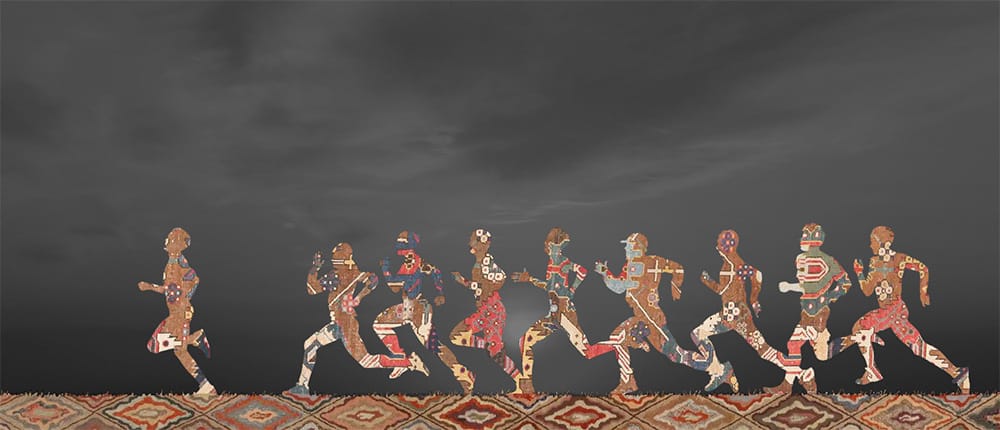
Runner Rugs
Decorating with runner rugs
The humble old runner rug is one of the most convenient antique carpet types available today. These practical and versatile rugs are ideal for outfitting hallways and dividing large spaces. Even native Persians preferred the elongated runner format when selecting carpets for their own homes. Today, there are broad corridor carpets, narrow hall carpets and skinny hallway runners that can effectively transition or partition irregular spaces. Hallway runners are available in an amazing variety of styles. There are contemporary runners, traditional runners and classical pieces that feature stunning Persian arabesques.
Antique runner rugs can effortlessly elevate the style of a stark corridor or create a striking visual partition that separates a secluded conversation area from a defined walkway. In the hallway or as the star of the room, rug runners have an alluring style and attractive form that can instantly change the look of any space.
Carpet runners are traditional lengthier rugs that often present in a multitude of different styles and colors. Practically every variety of weaving has developed a type of runner rug that benefits from the unique style’s color choices and foreground motifs.
These long and narrow rugs are powerful decorative elements because they can effortlessly grace longer sections (such as hallways) in the home. Their length makes them particularly desirable among collectors as well, as they are easier to display on wider and taller walls, resulting in a more elegant tapestry effect.
Their long and narrow shape makes them unique among other rectangular rugs for their more specialized arrangement potential. Set them alongside other rugs and smaller pieces of furniture before they lead to another room to create an even stronger degree of synergy between your furnishings.
Runners emphasize form and symmetry, which allows them to stand out in all types of environments even better. Though they run longer and are most commonly set vertically, many decorators may also choose to set the rugs horizontally against a curio wall or any other point of interest in the room.
If you have a section of negative / empty space that you would like to unify, try to use the symmetrical appeal of the hall runner to your advantage. You do not need to set it far against the wall in order to create a bridge between the visual points that would work best in the room.
Using runner rugs to protect your floors in higher foot traffic areas of the home
Runners also provide homeowners with necessary practical appeal, as they are more capable of protecting longer sections of hardwood flooring than most other types of rugs. Because of their length and presentation, runners are often chosen to grace longer areas that are also prone to higher amounts of traffic. Places like walkways and hallways can benefit from the inclusion of a tasteful carpet runner. These rugs not only protect the flooring itself from traffic wear, but the patterns chosen can be a powerful way to unify different rooms and create a common decorating scheme.
Runner rugs are more comfortable to walk on
The use of a runner rug can also be more physically comfortable, especially if you enjoy walking barefoot around your home.
Run away with Beautiful Runner Rugs: The ultimate decor for any long, narrow space
Runner rugs are the decorative darling for any long, narrow space. They can effortlessly elevate a hallway or separate a walking path from a living area. Woven by many rug producing countries, the Oriental runner rugs have quite the intriguing story. This is mostly due to nomadic weavers’ looms that had to be light weight, small and easily portable.
Therefore, the rugs were limiting in width but could be infinite in length! Runner rugs can be super bright and tribal, or they can be feminine and floral. Some have simple designs, commonly found in our vintage rug collection, while others are very intricate, commonly seen in our collection of Persian rugs.
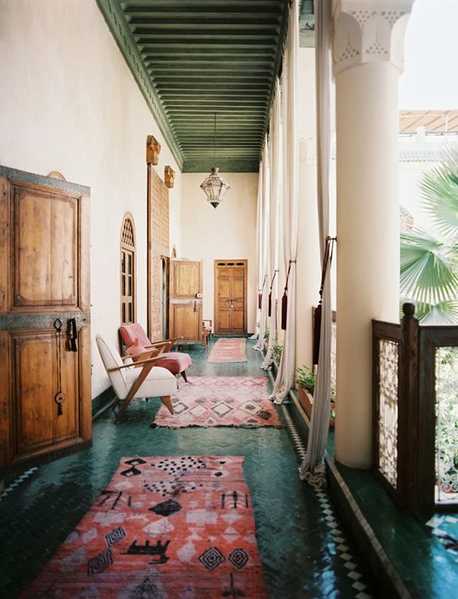
Antique And Vintage Runner Rugs
Run away with your runners from the Nazmiyal Collection today!
Choosing Runner Rugs and Other Design Elements for Your Hallways
It is easy to overlook hallways in your overall interior design scheme. After all, hallways are not rooms per se’, but transitional spaces that you use to get from one place to another. However, even though a hallway serves a largely utilitarian purpose, that doesn’t mean that it cannot become beautiful. Read on for our best hallway decor ideas.
For many people, the primary design element in a hallway is a rug or a runner. While decorative, it also serves practical purposes as well. However, you need not confine yourself to a rug alone when decorating a hallway. Regardless of the size of your space, you can incorporate other appropriate and attractive design elements.
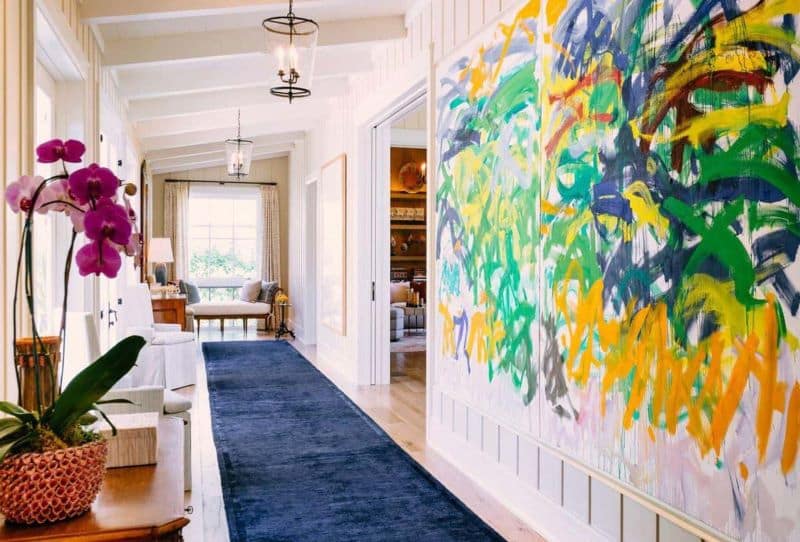
Hallway decor is an important part of interior design.
How To Choose a Hallway Runner Rug
No matter what the floor covering you already have in your hallway, whether it be a hard floor or carpet, you can also incorporate a rug or runner. The hallway is a high-traffic area, which can put unusual amounts of wear and tear on your carpeting. Placing a rug over the carpet in the hallway can help protect it from these forces, as well as spills, tracked-in mud, and other potential hazards.
However, because the hallway is an area that sees a lot of traffic, it is important to secure your rug securely to the floor to prevent slips and falls. Double-sided carpet tape can be helpful in this regard, as can nonslip liner made of rubber.
When you’re choosing your perfect rug or hallway runner rug, do not choose one that spans the entire width of your hallway or gallery. Part of the purpose of a hallway rug is to create leading lines and depth that make the space look longer by drawing the eye into the distance. To create these leading lines effectively, you need at least 2-3 inches of space on each side of the runner. Be sure you carefully measure both the hallway and the rug before purchasing the latter.
When choosing a color palette for your hallway decor ideas, including the rug, consider neutral tones. This is especially important if every room leading off the hallway has a different color scheme. Anyone traversing the hallway will probably be able to see into the different rooms. You probably cannot match all of them, but when you decorate the hallway in neutrals, you can complement each of them.
The palette that you choose also affects the overall feel of the space, so keep this in mind when choosing colors. Because hallways tend to be dark, narrow spaces, many people try to use color to open them up. If this is your objective, try lighter shades of cool colors or cool-tinged neutrals. The eye perceives these colors as receding into the distance, which can nicely complement the leading lines that you create with your runner. However, you may prefer a cozy, den-like feeling for your hallway. If so, you should choose darker colors leaning toward the warmer side of the spectrum.
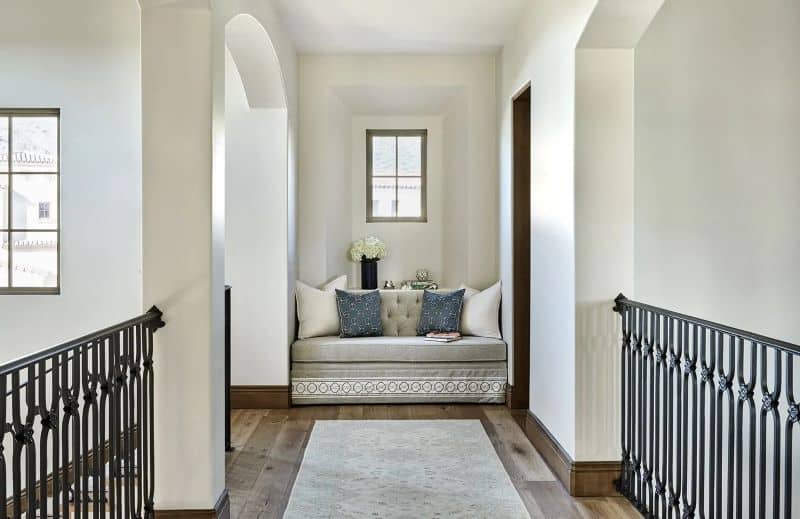
Choosing neutral colors for your hallway can complement the rest of your home.
How To Choose Other Hallway Design Elements
Your hallway decorating concept may start with a rug or runner, but it certainly doesn’t have to end there. There are many more elements that come into play. Take light, for example. Since hallways are typically lacking natural light, you will often have to add this element yourself.
If you rent your home rather than owning, this can be a challenge since you are not at liberty to rewire the space. Nevertheless, you can compensate with less permanent lighting, such as a floor lamp, if there is sufficient space for it. Otherwise, string lights that hang from the ceiling can use the space efficiently while effectively lighting the area. If your lighting options are limited, consider a lighter color palette for your hallway design, as it will reflect more and optimize the light you do have.
Speaking of reflection, for those who want to make a narrow hallway feel more open, mirrors are an invaluable asset. Not only do they reflect the space to make it seem bigger than it is, but they also reflect light to make it seem brighter. A large decoration, such as a bouquet of flowers or a potted plant, may overwhelm the hallway. However, place a smaller decoration next to a contemporary mirror, for example, and it seems to double in size while taking up less space.
Because people tend not to linger in the hallway, this is probably not the place to put your greatest art treasures. However, this does not mean that your walls must remain bare. Simple pictures, such as kids’ drawings or family photos, or wall hangings / tapestries can be appreciated as people walk past. You can unify these with matching frames, but avoid a gallery arrangement as it might prove overwhelming.
An attractive storage unit, such as an antique armoire for linens, may lend a hallway a touch of character and class. However, be careful that the unit you choose does not become a collecting place for toys, keys, and other clutter.
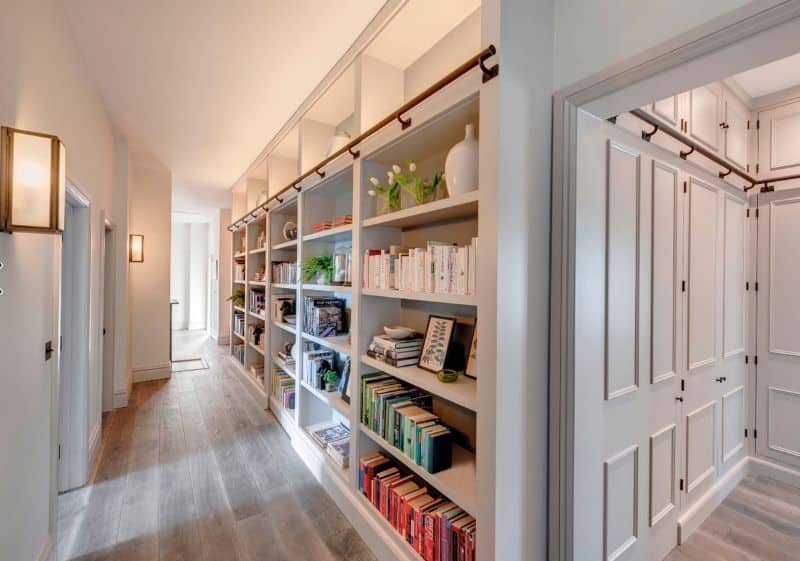
Adding a storage element to your hallway is practical and can look great.
Whether your tastes run classical, contemporary, or somewhere in between, the Nazmiyal Rug Collection features rugs in multiple styles, colors, and sizes. Browse our impressive selection or search for specifics.








